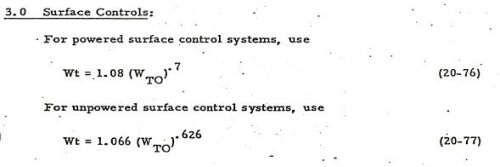icyplanetnhc (Steve)
Trekking into the cosmic ocean
Hi everyone,
I'm currently performing component research for our senior design project. Our mission requirements currently call for a fairly small UAV with a takeoff weight in the neighborhood of 100 lbs, with a Vmax of 120 mph, and a service ceiling of less than 10,000 ft. In our preliminary design, we are performing a component weight and drag buildup, but the equations for such buildup found in our design books, such as Fundamentals of Aircraft Design by Leland Nicolai and Aircraft Design: A Conceptual Approach by Dan Raymer, don't scale particularly well for an aircraft of our weight class. Specifically, using Nicolai's small aircraft weight estimation for surface control weight (given below), our iterative methods resulted in surface control weight accounting for about 40% of our takeoff weight, which is not reasonable. To address this issue, I've been researching individual actuators, but I believe an aircraft of our size is too large to employ typical hobby servos, and my research of UAV in our weight class, such as the RQ-15 Neptune or even somewhat larger aircraft such as the RQ-2 Pioneer hasn't yielded much useful information regarding surface control mass. For an aircraft in our weight class, are there general rule of thumbs for estimating the mass of surface controls?
- Steven
I'm currently performing component research for our senior design project. Our mission requirements currently call for a fairly small UAV with a takeoff weight in the neighborhood of 100 lbs, with a Vmax of 120 mph, and a service ceiling of less than 10,000 ft. In our preliminary design, we are performing a component weight and drag buildup, but the equations for such buildup found in our design books, such as Fundamentals of Aircraft Design by Leland Nicolai and Aircraft Design: A Conceptual Approach by Dan Raymer, don't scale particularly well for an aircraft of our weight class. Specifically, using Nicolai's small aircraft weight estimation for surface control weight (given below), our iterative methods resulted in surface control weight accounting for about 40% of our takeoff weight, which is not reasonable. To address this issue, I've been researching individual actuators, but I believe an aircraft of our size is too large to employ typical hobby servos, and my research of UAV in our weight class, such as the RQ-15 Neptune or even somewhat larger aircraft such as the RQ-2 Pioneer hasn't yielded much useful information regarding surface control mass. For an aircraft in our weight class, are there general rule of thumbs for estimating the mass of surface controls?
- Steven

